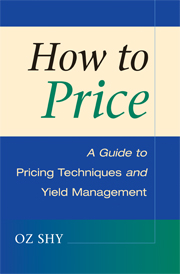Book contents
- Frontmatter
- Contents
- Preface
- 1 Introduction to Pricing Techniques
- 2 Demand and Cost
- 3 Basic Pricing Techniques
- 4 Bundling and Tying
- 5 Multipart Tariff
- 6 Peak-load Pricing
- 7 Advance Booking
- 8 Refund Strategies
- 9 Overbooking
- 10 Quality, Loyalty, Auctions, and Advertising
- 11 Tariff-choice Biases and Warranties
- 12 Instructor and Solution Manual
- References
- Index
4 - Bundling and Tying
Published online by Cambridge University Press: 06 July 2010
- Frontmatter
- Contents
- Preface
- 1 Introduction to Pricing Techniques
- 2 Demand and Cost
- 3 Basic Pricing Techniques
- 4 Bundling and Tying
- 5 Multipart Tariff
- 6 Peak-load Pricing
- 7 Advance Booking
- 8 Refund Strategies
- 9 Overbooking
- 10 Quality, Loyalty, Auctions, and Advertising
- 11 Tariff-choice Biases and Warranties
- 12 Instructor and Solution Manual
- References
- Index
Summary
Bundling and tying are widely used instruments for implementing price discrimination. Market segmentation is therefore accomplished by offering consumers a variety of packages to choose from. When bundling is used, by choosing different packages, consumers implicity reveal their willingness to pay for different quantity levels of the same good. That is, consumers with a high preference for large quantities will choose large bundles, whereas consumers with a low preference for large quantities will choose small bundles, or simply buy one unit, if available. Similarly, when tying is used, consumers implicitly reveal their preferences for some other types of goods, which are tied to the sale of the original good. Both the bundling and tying pricing techniques constitute special cases of nonlinear pricing under which the price of each unit may vary with the total number of units purchased.
The terms bundling and tying are used interchangeably both in the academic literature and by pricing experts. In this book, however, we draw a sharp distinction between these two marketing instruments. We will be using the following terminology:
DEFINITION 4.1
(a) We say that a seller practices bundling if the firm sells packages containing at least two units of the same product or service.
(b) We say that a seller practices tying if the firm sells packages containing at least two different products or services.
- Type
- Chapter
- Information
- How to PriceA Guide to Pricing Techniques and Yield Management, pp. 115 - 150Publisher: Cambridge University PressPrint publication year: 2008

